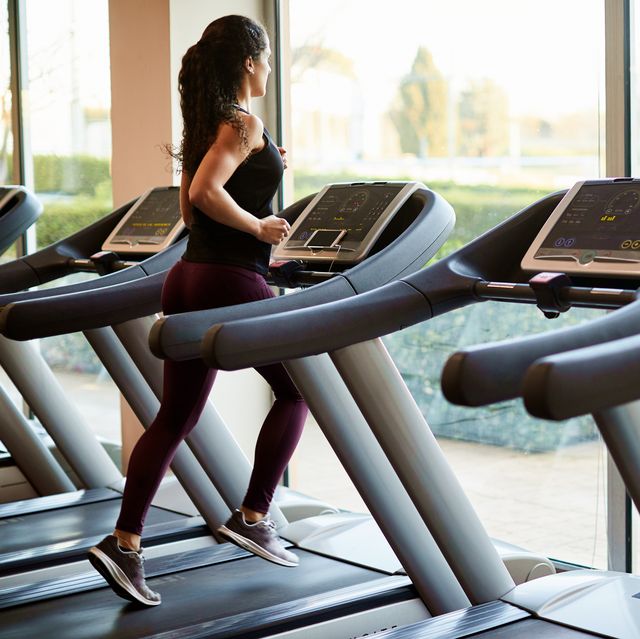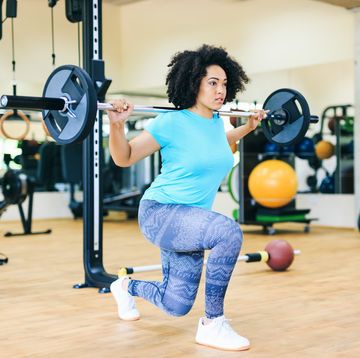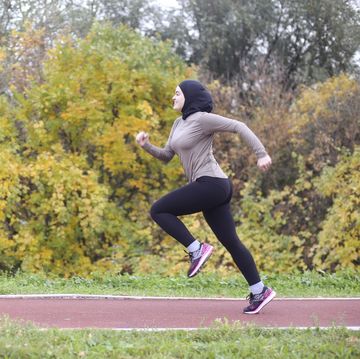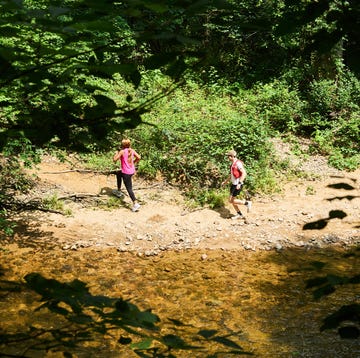- A new meta-analysis published in Sports Medicine found that running outside and running on the treadmill are relatively similar.
- If you are experiencing injuries, one surface may be more beneficial to run on than the other.
- For the average runner, it’s not necessary to add a 1 percent incline to get the same workout as running outside.
Whether you’re running on the treadmill or running outside, you’re still running. But the two ways certainly feel different for many runners.
For one, cranking out miles on the ’mill can feel downright tedious—you’re practically stationary with no views to distract you unless you have a TV set up right in front—while running outside provides you fresh air, a change of scenery, and a change of surface.
However, recent research concluded there are a few times when logging runs one way over the other is more beneficial, but overall the two forms aren’t so different.
In the meta-analysis, published in Sports Medicine, researchers analyzed 33 studies that compared running on motorized treadmills to running outside. They found that both surfaces give you a relatively similar run. The slight observed differences included footstrike, knee flexion, and vertical displacement of the pelvis (how much you bounce up and down) as you run. Researchers also found that surface can make the biggest difference based on certain types of injuries, and they looked at if a 1 percent incline really makes a difference. (Spoiler: for the most part, it doesn’t.)
When running on the treadmill, people were observed to have a less pronounced heel strike—landing more toward the mid or front of the foot. And when running outside, people tended to have more of rearfoot strike. This change in biomechanics is likely because your body is trying to compensate for surface differences, lead study author Bas Van Hooren, Ph.D.(c) in health, medicine, and life sciences at Maastricht University in the Netherlands, told Runner’s World.
These minor differences may be due to anything from your comfort level running on a treadmill (previous studies, which tested cadence of inexperienced treadmill runners, found the more uncomfortable you are, the more frequently you’ll strike the ground), the fact that when you push off on a treadmill the speed of the belt will slightly alter your gait, to the fact that your body bounces up and down less on the treadmill compared to running on the ground, which the review found may be due to that higher running cadence.
If you’ve been injured, here’s where you’ll want to pay attention. One study found you’ll experience lower bone strains on the tibia (your shinbone) when running on a treadmill compared to running outside, which can be beneficial when rehabbing from stress fractures, VanHooren explained. This may be due in part to certain treadmills having a less stiff surface than running on concrete, which can decrease the force on these bones. However, if you’re struggling with calf or Achilles tendon injuries, running outside may be more beneficial because it may put less force on these muscles and tendons, likely because people land more toward their midfoot or forefoot on the treadmill, said Van Hooren.
So what about adding a 1 percent incline to your treadmill runs to mimic the intensity of outdoor running and make up for lack of air resistance? Turns out, most runners don’t need to do that to see a difference in resistance and push off—it’s already pretty similar to what you’d experience running outside.
That’s because the average runner wouldn’t need a 1 percent incline to compensate for the resistance they’d experience outside—you need to push on the belt with similar force needed to propel yourself forward outside, you’re not just picking up your feet, explained Van Hooren. Adding the 1 percent incline will typically be beneficial for someone who runs faster than about 8 to 10 miles per hour (around a 7:26 to 6:02 minute/mile) to compensate for lack of air resistance when running indoors at these speeds, as found by a previous study published in Sports Medicine.
[Download the All Out Studio App for more amazing Runner’s World workouts!]
Overall, people may experience a different feeling running on the treadmill than overground due to things like how comfortable the runner is on the ’mill, which may affect the stride, or simply because they find running on the treadmill to be boring or feel harder, Van Hooren explained.
When you’d really want to pay attention to your running surface is if you’re experiencing certain injuries. However, if you need to get a run in, whether outside or in the gym, choosing one over the other won’t necessarily give you a better workout.














